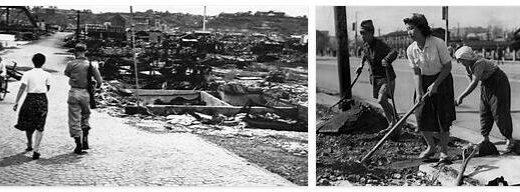Japan During The Ashikaga Part II
Among Nobunaga’s generals we find another of the greatest figures in Japanese history: Toyotomi Hideyoshi (1536-98). Of humble birth, he had entered his service at a very young age and was immediately appreciated for his lively intelligence and valor. In 1577 Nobunaga entrusted him with the campaign against Mōri Terumoto, who, in a few years, had taken over the entire Chūgoku peninsula. The operations proceeded slowly due to the strenuous resistance opposed by Terumoto; in five years, however, Hideyoshi’s troops managed to seize some provinces, but the continuation of hostilities requiring reinforcements, Nobunaga sent Akechi Mitsuhide to him at the head of 30,000 men. For some time he had harbored a secret and profound hatred for his master to whom he owed the death of his mother; assumed, therefore, the command, he thought the moment of vengeance had come, whereby, instead of flying to Hideyoshi’s aid, he swooped into Kyōto and attacked Nobunaga, forcing him to kill himself in the temple of Honnōji, where he had taken refuge wounded (22 June 1582). This done, he proclaimed himself shōgun. But his charge had to be ephemeral, because Hideyoshi, informed of what had happened, quickly concluded the peace with Terumoto and flew against the traitor, who, defeated, was killed in Yamazaki. Shortly thereafter, a council of the Ōda family and vassals, chaired by Hideyoshi, designated heir of the deceased Sambōshi, his nephew, entrusting his protection, until adulthood, to his uncles Nobuo and Nobutaka. But Hideyoshi’s omnipotence, which gave him a preponderant place in the affairs of the country and made him consider him a usurper of the power so painfully conquered by Nobunaga, and his low origin, which had made him regard him as an intruder in the question of succession, must in short create rivals. Before, Nobutaka rebelled against Hideyoshi, who sent him against his brother, who, defeating him, forced him to kill himself. Then, even between Hideyoshi and Nobuo disagreements arose, whereby he, asking for help from Tokugawa Ieyasu, marched against Hideyoshi. The meeting took place in Komakiyama, but the two armies did not come to blows because their leaders thought it better to come to negotiations, and a marriage between Asahi-no-kata, Hideyoshi’s daughter, and Ieyasu sealed the peace (1584). Hideyoshi therefore gave to the construction of the Ōsaka castle, and Ieyasu of what will be the future residence of the shōgun of his home, in Yedo. The work of pacification of the country continued and other rebel feudal lords were subdued, while the power of Hideyoshi was increasingly affirming itself.
According to BEAUTYPICALLY, for a long time Hideyoshi’s hegemonic ambition had turned to Korea and China, but events had forced him to postpone the realization of his dream to better times. Having now consolidated his position within the company, he believed that the time had come to undertake the undertaking. The pretext was offered by the fact that for many years Korea had no longer sent the usual annual embassies. To the grievances of the dictator, the Korean government sent an embassy in 1590 which was made to wait several months before being received. Upon his return to his homeland, after having subjected her to insulting treatment, Hideyoshi entrusted her with a letter in which, explicitly declaring his intention to invade China, he asked the Koreans to help him. The king of Korea refused, proclaiming himself a vassal of the emperor of China. The operations then began. A first expedition conquered the peninsula, forcing the king to flee to China in search of help (1592). The intervention of the Chinese, the extension of the front of operations, the rigors of the winter that arrived, the difficulties of communications and supplies soon forced the Japanese, after a tiring victory over the Sino-Koreans in Pa-chung, to start peace negotiations with China, but the negotiations, due to the conditions imposed by this, failed, leading to the resumption of hostilities. A second expedition of 100,000 men could only remain on the defensive. Meanwhile (September 15, 1598) Hideyoshi died, leaving his five-year-old son Hideyori heir, and entrusting the government, during his minority, to a council made up of the country’s five major daimyō, including Tokugawa Ieyasu. His death marks the failure of the Japanese hegemonic attempt in China.
With Hideyoshi gone, the horizon clouds again. Soon Ieyasu was accused of wanting to supplant his protégé, whom he had sworn to his dying father to protect, and a coalition of great daimyō formed against him. The hostilities, which began in August 1600, ended in October in Seki-ga-hara, where he won a sensational victory that was to give him the supremacy forever. Having thus cleared the field of enemies, Ieyasu withdrew to Fushimi, where, assisted by Fujiwara Seikwa and Hayashi Dōshun, he set about the elaboration of that system of reforms that was to ensure power for his posterity for two and a half centuries. In 1603 the emperor Go Yōzei (1587-1611) bestowed on him the title of shōgun and, two years later, he abdicated in favor of his son Hidetada, for the main purpose of making and having the office recognized as hereditary. From Sumpu, in the province of Shizuoka, his retirement, he continued to direct the government, while turning the activity to the studies, of which he favored the diffusion and progress. As for Hideyori, the inscription on a bell he had melted and interpreted by Ieyasu as intentionally irreverent towards his own person, provided him with a pretext, ultimately desired, to get rid of it. In June 1615, Hideyori and his partisans perished in the flames of the Ōsaka castle, which was besieged by Ieyasu’s troops. Another version, unofficial, instead makes him flee, with the consent of Ieyasu, in southern Kyushu, where he would have adopted the name of Tanimura.



